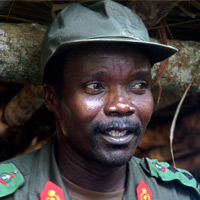
Operation Lightning Thunder,1 the joint military operation against the Lord’s Resistance Army, or LRA, did not succeed in its goal of ending the LRA threat. Instead, it sparked harsh reprisals by the LRA against civilians in northeastern Congo, the site of the LRA’s current atrocities in central Africa.2 However, it would be an even greater tragedy for civilians if key states in the region and the international community lost their collective will to end the threat of the LRA for once and all. What is needed now is a second Ugandan-led operation against the LRA—with strong international backing and operational support.
Enough’s latest strategy paper argues that the United States should take the lead in supporting a new Ugandan-led military operation by providing solid planning, intelligence, coordination, and logistical support, as well as by taking greater responsibility for the execution and outcomes of the operation.
“The only way to finally bring an end to the LRA’s terror is by apprehending or otherwise removing those key LRA leaders responsible for ongoing atrocities, says Julia Spiegel, Enough’s Uganda-based LRA researcher and one of the paper’s co-authors.
| TAKE ACTION: Elected officials must hear from their constituents in order to make addressing the crisis caused by the LRA a top priority. Call your Senator today by dialing the Capitol Hill switchboard at (202) 224-3121. Tell them to urge President Obama to help end the reign of terror of the LRA. You can also join Enough and our partners at Invisible Children and Resolve Uganda in participating in Lobby Days, June 22-23 in Washington, D.C. Click here for more information. |
The United States’ strategic role and responsibility
The Bush administration had a major role in encouraging and supporting regional military operations against the LRA, and the U.S. military was directly involved in ‘Lightning Thunder.’ The Obama administration now has a responsibility and opportunity to help finish the job, which can be successfully accomplished through a combination of political pressure and operational support for a new Uganda-led initiative to eliminate the LRA with a top-down approach.
The hard lessons of ‘Lightning Thunder’:
Cooperation between Uganda, Congo, and Southern Sudan in addressing the LRA as a shared regional threat is a major breakthrough, and should be welcomed by the international community. However, the operation failed to apprehend or remove Joseph Kony and key LRA leaders, and has only exacerbated the threat against civilians. Though the LRA is largely dispersed and on the run, more than 1,000 people have been brutally murdered and nearly 250 children have been abducted since mid-December 2008.
A few positives
The joint operation demonstrated a level of communication and cooperation between the governments of Congo, Uganda, and southern Sudan that is unprecedented in recent history. The regional armies destroyed some of Kony’s main camps, rounded up various stores of food, ammunition and communication equipment, rescued several dozen abductees, and killed some rank-and-file fighters, but much more is needed to successfully end the reign of the LRA instead of just causing setbacks.
What went wrong?
Although ‘Lightning Thunder’ did achieve some relative gains, several major shortcomings seriously hindered the operation’s effectiveness and must be addressed before a second military effort is undertaken. Poor operational planning, dysfunctional collaboration among the major players, and insufficient prioritization for the protection of civilians ultimately doomed the success of this operation.
Finishing the fight
The Ugandan army is the only force in the region that can quickly mobilize to finish the fight against the LRA, though a second Ugandan-led operation must obviously avoid the mistakes of ‘Lightning Thunder.’ Any future attempt must focus on prioritizing civilian protection, coordinating and streamlining the rescue of LRA abductees, and ensuring accountability for crimes against humanity.
Although Operation Lightning Thunder has not dismantled the LRA leadership or seriously undermined the force’s ability to inflict harm, stopping the hunt now will result in more lives lost and communities destroyed in the months and years to come. Now is the time re-double and reinvigorate international and regional efforts to finally bring an end to the LRA’s devastating reign of death and destruction.
“Abandoning the mission to end the LRA now will have disastrous consequences for civilians through central Africa,” said paper co-author Noel Atama, an Enough researcher based in Congo. “Now is the time to re-double and reinvigorate international and regional efforts to finally bring an end to the LRA’s devastating reign of death and destruction.”
Endnotes
1 For more information on Operation Lightning Thunder, see Enough’s joint statement with Resolve Uganda, “No Excuses: The End of the Lord’s Resistance Army is in Sight.” return
2 For more than 20 years, the Lord’s Resistance Army, or LRA, and its leader Joseph Kony have wreaked havoc on civilian communities across central Africa. What began in 1989 as a rebellion based in northern Uganda has morphed into a regional insurgency that now terrorizes civilians in southern Sudan, eastern Democratic Republic of Congo, and the Central African Republic. Learn more about the LRA on Enough’s special page. return

